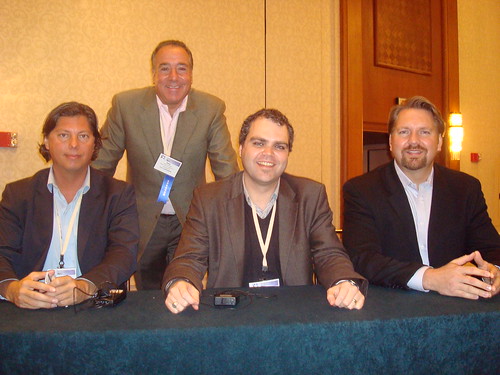
(Rob Key, Peter Himler, David Bradfield, Lee Odden)
Prior to being engaged to someone with far more social tact and less complete obliviousness towards social etiquette than myself, it would have never once occurred to me to bring a “host gift” to a party or get together.
As I mature and meet more and more people, however, I’m glad to have someone around who actually realizes that most social groups will adhere to often unwritten social rules (including “host gifts”), and will be unlikely to truly welcome someone into their group unless they follow them.
When looking at the changing PR landscape, particularly the presence of new forms of social media, what can PR professionals learn from this example?
Several examples were shared with attendees via a panel moderated by Peter Himler, President of Flatiron Communications LLC, and including:
- Rob Key, Founder & CEO of Converseon
- David Bradfield, Senior Vice President & Partner, FH Digital
- TopRank Online Marketing CEO Lee Odden
The most pressing example, offered by Key, relates closely to the analogy above, especially as one attempts to penetrate a social community for the first time:
- Listen and observe the group you are trying to penetrate
- Understand the wants, needs, and requirements for entrance into said group
- Gain trust and credibility by offering something of value when entering
A social network, like a party of new friends, has its own wants, needs and – per Odden – its own written and unwritten rules to be followed. Unless time is taken to listen to what those wants, needs and ruless are, and an effort is made to offer something of value based on this information, you will likely be seen as an outsider to the proceedings, unlikely to be involved in any meaningful party conversation, and risk the complete shunning of the group itself.
With the risk in of alienation high when leveraging social media in the new PR landscape, is the corresponding reward equally as rich? The answer is a resounding, and absolute yes.
As Himler posited in his moderation, stories often start off in very obscure places, and more and more these very obscure places could be a little know social network or forum. More and more, journalists are using search and social networks to find these nooks and crannies when developing facts, contacts or data for articles.
In fact, nearly 91% of journalists polled admitted to using search to research stories, per Odden. Additionally, journalists are oftentimes members of online social media communities – and are particularly active on Twitter where 140 character microblogs can be ideal for scaring up a contact for a story at the last minute.
Knowing that our target – in this case journalists, are leveraging social media and participate in social media communities, what key takeaways did the panel offer to PR professionals?
- Find out which of your targeted journalists are on Twitter, and build them into your network. Once trust is gained within this community (see above) you will find it much easier to have results with a 140 character microblog pitch that will actually be read, than a full email pitch that may blend with the rest of the noise.
- Speak in a language of the people with which you are trying to communicate. Again – spend time listening first before you begin to speak.
- Realize that this is the way PR is shifting – increasingly from a “push” tactic to a “pull” tactic as journalists find you as easily as you may find them.
With this dynamic shift, should PR professionals worry, or accept, that they are working in an industry that some may say is chasing its own tail in the sense that journalists & PR professionals are sharing and consuming information from each other in the same fashion?
“Luckily, our skills will transfer,” stated Key. “In the end, our new landscape and social media tools are simply taking us back to the very essence of communication.”
Through this changed and more profound landscape, public relations will experience both a harkening back, and rebirth – something very few industries can say.


